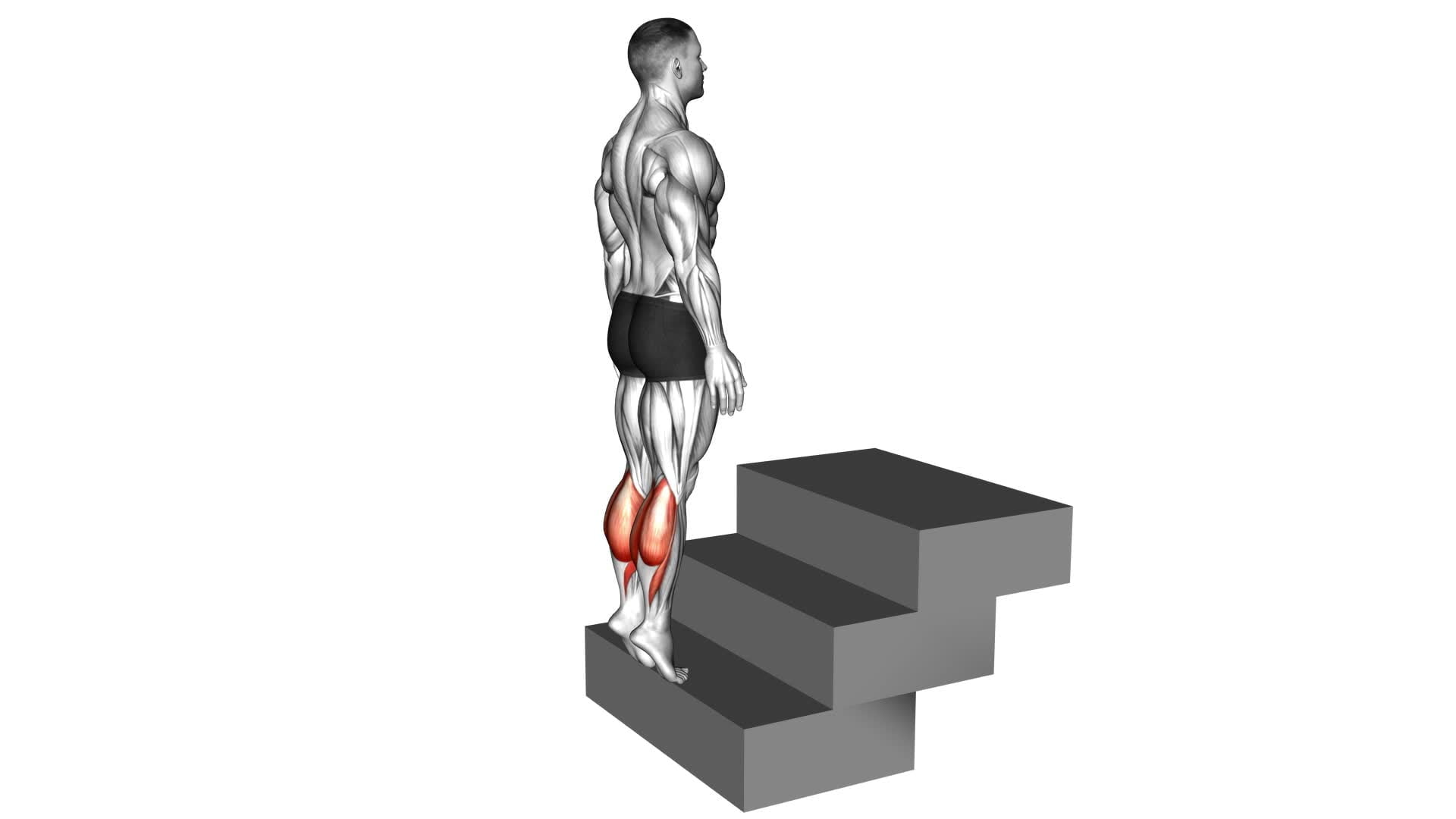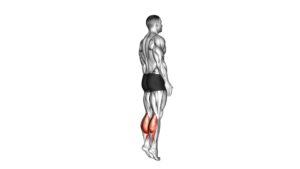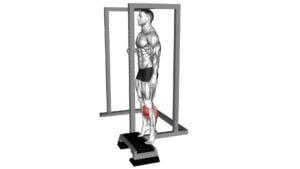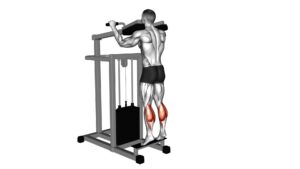Standing Calf Raise (On a Staircase) – Video Exercise Guide & Tips

Are you looking to strengthen your calf muscles? If so, the standing calf raise exercise on a staircase is perfect for you.
Watch This Exercise Video
In this video exercise guide, we will show you the proper technique, common mistakes to avoid, and tips for increasing intensity.
With variations to suit your fitness level, you'll be on your way to toned calves in no time.
Get ready to step up your calf game and watch the instructional video now!
Key Takeaways
- Standing calf raises can improve calf strength and muscle definition.
- They help stretch and lengthen calf muscles, enhancing flexibility and reducing the risk of injury.
- Standing calf raises target the gastrocnemius muscle for enhanced muscle definition.
- Incorporating variations and exercises can maximize calf muscle development.
Benefits of Standing Calf Raises
You can experience significant improvements in calf strength and muscle definition by incorporating standing calf raises into your workout routine. Not only are standing calf raises a simple exercise to perform, but they also provide a range of benefits for your calves.
One of the main benefits of this exercise is that it helps to stretch and lengthen the calf muscles. By performing standing calf raises, you're actively working to lengthen the muscles in your calves, which can help to improve flexibility and reduce the risk of injury.
Additionally, standing calf raises target the gastrocnemius muscle, which is the larger, more visible muscle in the calf. This means that by incorporating standing calf raises into your routine, you can achieve enhanced muscle definition in your calves.
Another advantage of this exercise is that there are different variations to choose from. You can perform standing calf raises on a flat surface, on an elevated surface such as a step, or even with weights for added resistance. This variety allows you to target different areas of the calf muscles and keep your workouts interesting and challenging.
Proper Technique for Standing Calf Raises
To perform standing calf raises with proper technique, begin by positioning yourself on a stable staircase. Stand with the balls of your feet on the edge of the step, allowing your heels to hang off. This position will ensure that your calf muscles are properly activated during the exercise.
Next, make sure your feet are hip-width apart and parallel to each other. This proper foot positioning will help you maintain balance and prevent any unnecessary strain on your ankles.
As you prepare to perform the exercise, engage your core and maintain an upright posture. This will help you stabilize your body and maximize the effectiveness of the calf raise.
To execute the movement, slowly raise your heels as high as you can by pushing through the balls of your feet. Make sure to keep your knees straight throughout the entire motion.
Pause for a moment at the top of the movement, then slowly lower your heels back down to the starting position.
Repeat this exercise for the desired number of repetitions, focusing on maintaining proper form and control throughout each repetition.
Common Mistakes to Avoid
When performing standing calf raises on a staircase, be mindful of common mistakes to avoid. Proper technique is crucial to effectively target and strengthen your calf muscles while minimizing the risk of injury.
One common mistake isn't maintaining proper alignment throughout the exercise. Make sure your feet are hip-width apart and parallel to each other, with your toes pointing forward. Avoid allowing your ankles to roll inward or outward, as this can put unnecessary strain on your joints.
Another mistake to avoid isn't using a full range of motion. It's important to lower your heels as far as possible without discomfort, and then rise up onto your tiptoes as high as you can. This will ensure that you're fully engaging and working your calf muscles.
Lastly, avoid relying on momentum or using excessive speed during the exercise. Instead, focus on controlled movements, both on the way up and down, to maximize the effectiveness of the exercise.
Tips for Increasing Intensity
To further challenge your calf muscles and increase the intensity of your standing calf raises on a staircase, consider incorporating these tips:
- Increasing weight: One effective way to amp up the intensity of your calf raises is by adding weights. You can hold dumbbells in each hand or wear a weighted vest to provide extra resistance. Start with a manageable weight and gradually increase it as you get stronger. This added resistance will force your calf muscles to work harder, leading to greater gains in strength and size.
- Proper warm-up: Before diving into your standing calf raises, it's crucial to properly warm up your calf muscles. This will help prevent injury and improve your overall performance. Begin with some light cardio exercises like jogging or jumping jacks to get your blood flowing. Then, perform dynamic stretches specifically targeting the calf muscles, such as ankle circles and heel drops. By warming up, you'll increase blood flow, flexibility, and range of motion, allowing for a more effective and safer calf workout.
- Eccentric contractions: Another way to increase the intensity of your calf raises is by focusing on the eccentric portion of the exercise. This involves lowering your heels down slowly and controlled, resisting the pull of gravity. The eccentric phase of any exercise is known to create more muscle damage, leading to greater muscle growth. So, instead of rushing through the movement, take your time during the lowering phase to maximize the benefits.
Variations of Standing Calf Raises
One way to vary your standing calf raises is by incorporating different angles of incline on the staircase. Changing the angle of incline can target different muscles within the calf, leading to better overall calf muscle development. By adjusting the angle, you can specifically target the soleus or gastrocnemius muscles, or even both simultaneously.
To target the soleus muscle, try performing standing calf raises on a flat surface. This exercise places more emphasis on the soleus, which is the smaller muscle located deeper within the calf. By keeping your knees slightly bent and focusing on a full range of motion, you can effectively work the soleus.
On the other hand, if you want to target the gastrocnemius muscle, which is the larger muscle located on the surface of the calf, try performing standing calf raises on an inclined surface, such as a staircase. By placing the balls of your feet on the edge of the step and allowing your heels to drop below the step, you can stretch the gastrocnemius muscle and activate it more effectively.
In addition to varying the angle of incline, there are alternative exercises you can incorporate to further challenge your calf muscles. Some examples include seated calf raises, donkey calf raises, and single-leg calf raises. By incorporating different variations and exercises, you can maximize your calf muscle development and achieve stronger, more defined calves.
Frequently Asked Questions
Can Standing Calf Raises Help With Ankle Flexibility?
Standing calf raises can definitely help improve ankle flexibility. By strengthening the calf muscles, you're also stretching and lengthening the Achilles tendon, which plays a crucial role in ankle mobility. Increasing ankle flexibility can benefit you in various ways, such as improved balance and stability, reduced risk of ankle injuries, and enhanced performance in activities that require ankle movement.
Adding ankle mobility exercises like standing calf raises to your routine can have significant benefits for your overall ankle flexibility.
Can Standing Calf Raises Be Done Without Any Equipment?
Yes, standing calf raises can be done without any equipment. They're a great exercise for strengthening and toning your calf muscles. By raising up onto your toes and lowering back down, you can work your calves effectively.
Additionally, standing calf raises have several variations that you can try to target different areas of your calf muscles. These variations include single-leg calf raises, seated calf raises, and calf raises with weights.
How Often Should Standing Calf Raises Be Performed for Optimal Results?
To achieve optimal results with standing calf raises, it's important to perform them regularly. The frequency of your workouts will depend on your fitness level and goals.
Incorporating different variations of standing calf raises can help target different muscles in your calves, leading to better overall development. These exercises offer numerous benefits, such as strengthening your calf muscles, improving ankle stability, and enhancing your overall balance and posture.
Consistency is key, so aim to include standing calf raises in your routine a few times a week.
Are Standing Calf Raises Suitable for People With Knee Pain or Knee Injuries?
Standing calf raises can be a great exercise for building strength and stability in the calves. However, if you have knee pain or injuries, there are alternative exercises that may be more suitable for you. It's important to listen to your body and consult with a healthcare professional before attempting any exercise.
Standing calf raises can provide benefits such as improved balance and ankle mobility, but it's crucial to prioritize your knee health and choose exercises that work best for you.
Can Standing Calf Raises Help Improve Balance and Stability?
Standing calf raises can indeed help improve your balance and stability. By targeting the muscles in your calves, this exercise strengthens the lower body and enhances proprioception, which is your body's awareness of its position in space.
This increased proprioception can greatly benefit athletes, as it allows for better control and coordination during movements. Incorporating standing calf raises into your routine can provide you with a solid foundation for improved balance and stability in various activities.
Conclusion
In conclusion, standing calf raises are an effective exercise for strengthening and toning the calf muscles. By following the proper technique and avoiding common mistakes, you can maximize the benefits of this exercise.
Additionally, incorporating variations and tips for increasing intensity can help you progress and challenge your calf muscles even further. So, add standing calf raises to your workout routine and watch your calves become stronger and more defined.

Author
Years ago, the spark of my life’s passion ignited in my mind the moment I stepped into the local gym for the first time. The inaugural bead of perspiration, the initial endeavor, the very first surge of endorphins, and a sense of pride that washed over me post-workout marked the beginning of my deep-seated interest in strength sports, fitness, and sports nutrition. This very curiosity blossomed rapidly into a profound fascination, propelling me to earn a Master’s degree in Physical Education from the Academy of Physical Education in Krakow, followed by a Sports Manager diploma from the Jagiellonian University. My journey of growth led me to gain more specialized qualifications, such as being a certified personal trainer with a focus on sports dietetics, a lifeguard, and an instructor for wellness and corrective gymnastics. Theoretical knowledge paired seamlessly with practical experience, reinforcing my belief that the transformation of individuals under my guidance was also a reflection of my personal growth. This belief holds true even today. Each day, I strive to push the boundaries and explore new realms. These realms gently elevate me to greater heights. The unique combination of passion for my field and the continuous quest for growth fuels my drive to break new ground.



